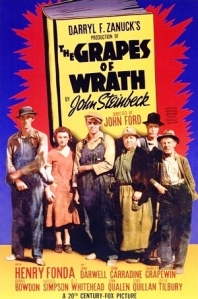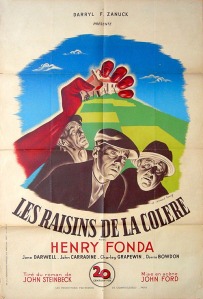Dir. John Ford. Run Time: 129 mins. PG
(U.S Release Poster)
Based on the landmark novel by John Steinbeck, John Ford’s film adaptation of The Grapes Of Wrath has become almost as large a cultural force as its inspiration. It was selected as one of the first twenty-five films to be archived in the Library Of Congress as a significant cultural artefact and, in my opinion, this was done with very good reasons.
The story of the Joad family making the trek from Oklahoma through to California in search of work during the American depression will be familiar to many people, and as such I will not talk at length about the film’s plot. What I will discuss, however, is the deftness with which this material is handled by Ford.
Gritty and realistic the photography and direction of the movie is one of the high points of cinema history. Nothing appears by accident, but nothing is drawn too obviously to the audiences attention. Tom Joad (wonderfully played by Henry Fonda) lighting hand-rolled cigarette in a moment of quiet contemplation, ex-preacher Casy’s (John Carradine) nervous twitching as he tries to find his role in the world, and the Joad kids’ (Darryl Hickman and Shirley Mills) resigned playing as their stomachs softly growl: all of this is shown with such a lack of overt stylisation that they become sort of the most touching and heart-wrenching images to be displayed outside of a documentary.
The attention to detail too is great to witness. The actors wear no make-up as they play their parts in an effort for realism and the car that takes them on their trying journey is the same Hudson “Super Six” Sedan described by Steinbeck. Nothing feels staged or overly Hollywood, but rather it all comes across so naturally that one can almost smell the miasma of dirt and sweat that surrounds this unhappy lot.
I think, however, that some of the biting realism of this film have been lost over the years, or at least relegated to being somewhat of a quaint charm. I mean, Steinbeck’s novel is taught in many schools and people have become very familiar with the story over the many years since it was written, and this is be no means a bad thing (in fact it makes me happy to think that Steinbeck is still so well respected and widely read), but it does mean that someone sitting down to watch The Grapes Of Wrath for the first time is unlikely to have anything similar to the reaction that audiences had at the time.
The socialist undertones and dissection of the pain caused by a capitalist system left to its own devices now come as part of the package when one hears the title The Grapes Of Wrath, no longer will one be surprised, shocked, and reduced to tears of righteous indignation when these images are presented to them. The discussion of ‘pinks’ and ‘reds’ are not so immediate to a modern audience as to make them bristle with deep-rooted political allegiances, but rather they pass the modern viewer by completely or serve only as some historical curiosity of a bygone time.
I suppose that it is better that the conditions of Steinbeck’s book and Ford’s film do not persist to the current day, but it is still somewhat of a shame that these reactions have been lost, and that a full visceral understanding of the film is almost unattainable today. But still the film must be viewed as a triumph and a masterpiece which does and will remain relevant now and for a long time to come.
SIDENOTE: The Grapes Of Wrath is listed at #136 on the list of 1001 Movies You Must See Before You Die.
SIDENOTE: INTERESTING FACT: The Grapes Of Wrath was initially banned from being shown in Russia despite its strong socialist bent. Stalin objected to the film because it showed that even the poorest of American families could still afford a car.
RATING: 10/10
(French Release Poster)
Related articles
- Gov’s ‘poor’ excuse misses job issue (utsandiego.com)
- What would YOU do? (swagmeisterlay.wordpress.com)
- AP English Lit ISA-The Grapes of Wrath Research Unit (waltonhigh.typepad.com)
- “The Grapes of Wrath” by John Steinbeck (voiceofrussia.com)
- #183 (tie) – The Grapes of Wrath (1940), dir. John Ford (fanwithamovieyammer.wordpress.com)
- A History of the American Route Marker and Route 66 (roadtrafficsigns.com)
- From Caldwell to Ford: The Curious Case of TOBACCO ROAD (1941) (thebadthebeautiful.wordpress.com)
- Grapes Of Wrath Book Report (buybestessayscheap.wordpress.com)
- The Grapes Of Wrath… Americans Will Turn On Other Americans (themadjewess.com)
- The Grapes of Wrath (shona49001.wordpress.com)




